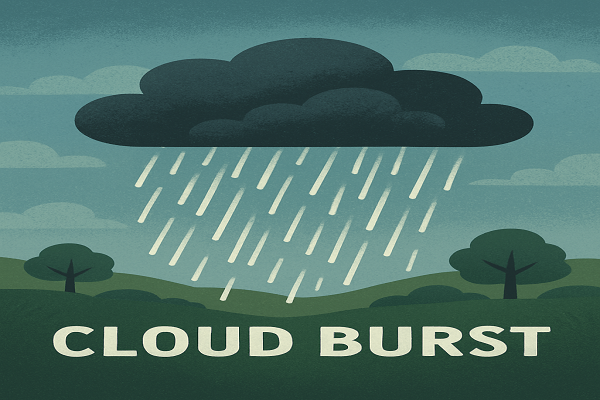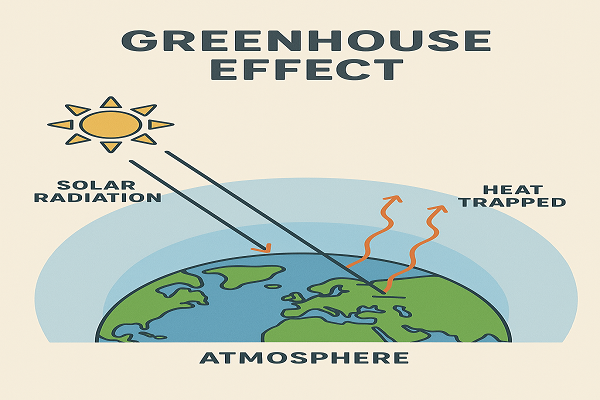Cloud Burst

A downfall flood tide drift is a flood tide drift phenomenon caused by heavy downfall, which leads to a rapid increase in the volume of gutters and a sharp rise in water situations. It’s also appertained to as a downfall flood tide drift and is the most common and most threatening type of flood tide drift. According to the cause,
it can be divided into unlooked-for downfall cataracts, typhoon downfall cataracts, and anterior downfall cataracts, which are caused by showers, typhoons, and anterior rain singly. The characteristics of downfall cataracts are affected by the intensity of the downfall, the path of the center of movement, and the underpinning face conditions
unlooked-for downfalls are short- lived, have high peaks, and constantly do in small corners. Typhoon downfalls are common in coastal areas, with high peaks and large volumes. Anterior downfalls cover a wide area and can easily form combined disasters in large corners.
Torrential cloudbursts can spark secondary disasters, similar as flash cataracts and debris overflows, and are characterized by suddenness, rapid-fire flux, and great destructive power. Cataracts in China and the world’s medium- and low- latitude regions are primarily caused by heavy rain, with a total area of 738,000 square kilometers, primarily in the lower pealed of the seven major gutters and along the southeastern coast.
Hothouse effect and global warming

Heat on Earth’s face comes primarily from the sun. When solar radiation( visible light) reaches Earth, some is reflected into space by shadows( analogous to ocean ice and murk), warming the Earth. Still, infrared radiation from Earth’s face is released back into space, cooling the earth. still, the Earth’s long- term average temperature would remain roughly constant If the Earth’s heating and cooling were roughly equal.
Still, the laws of medicines dictate that the average face temperature would be around-18 degrees Celsius If the Earth had no atmosphere.
Without atmosphere
But Earth has an atmosphere. Some gases in the atmosphere, analogous to carbon dioxide, help the Earth from radiating heat into space. Hothouse feasts absorb some of the Earth’s infrared radiation and reradiate it in all directions.
Some of this radiation escapes into space, but some is reflected to Earth and warms the Earth. This is the hothouse effect, and the feasts are hothouse feasts. Presently, the average face temperature of the Earth is around 15 °C.
Schematic illustration of the hothouse effect

Increased hothouse gas situations reduce infrared radiation reaching space, entrapping heat within the Earth and leading to a warming of the climate system. Face warming is one manifestation of global warming.
Rising face temperatures may spark other changes, some of which can complicate warming( positive feedback). For illustration, global warming reduces ocean ice and snow cover, exposing farther ocean and land. Because the albedo of ocean water and land is lower than that of ocean ice and snow,
Earth’s capability to absorb solar heat increases. As the ocean and land absorb farther heat, they warm, causing farther ocean ice and snow to melt, creating a vicious cycle.
According to the IPCC’s Sixth Assessment Report, under
A truly high hothouse gas emigrations script( SSP5- 8.5), the global average face temperature between 2081 and 2100 is truly likely to be 3.3 to 5.7 °C advanced than the 1850- 1900 normal. Global warming not only alters the climate and natural systems but also affects mortal exertion, society, and civilization.
Hothouse feasts produced by mortal exertion
The main hothouse feasts in the atmosphere are carbon dioxide( CO 2), methane( CH 4), nitrous oxide( N 2 O), chlorofluorocarbons( CFCs), and ozone( O 3). Although water vapor( H 2 O) in the atmosphere is also a hothouse gas, it plays only a supporting part. Carbon dioxide is the primary controller of global temperature.
There is no distrust that mortal influence is warming the atmosphere, abysms, and land. Due to mortal exertion, global atmospheric attention of carbon dioxide, methane, and nitrous oxide has risen dramatically since 1750.
Carbon dioxide attention is now at situations not seen in at least 2 million times, while methane and nitrous oxide attention are at situations not seen in at least 800,000 times. The increase in carbon dioxide attention is primarily caused by the combustion of reactionary powers and deforestation, whereas the increase in methane and nitrous oxide attention is caused by husbandry.



